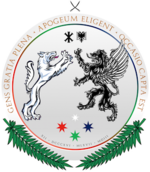Senato Repubblicana
Senato Repubblicana | |
|---|---|
| Type | |
| Type | |
| History | |
| Founded | November 21, 1503 |
| Leadership | |
Chair of the Senate | Stefanos Megarsis (PSDC) |
Leader of the Government | Dragos Dovanescu (PSDC) |
Leader of the Opposition | Letizia Borletta (FPD) |
| Structure | |
| Seats | 100 Single-member, instant-runoff |
 | |
Political groups | Government (72):
Pacitalian Social Democratic Congress: 72 seats
Main opposition (19): Federation of Progressive Democrats: 19 seats
Third parties (9): Empordian Socialist Party: 7 seats
Christian Democrats: 2 seats
|
Length of term | 3 years |
| Elections | |
| Instant-runoff voting | |
First election | 1503 |
Last election | 2020 |
Next election | 2023 |
| Motto | |
| COGITEMVS • EXCOLANTVS • MELIORAMVS "We ponder, we refine, we make better" (Latin) | |
| Meeting place | |
 | |
| Interior of the Senato chamber | |
 | |
| Exterior of the Senatorial wing of the Prado, the Pacitalian parliament building, in Timiocato | |
| Website | |
| gov | |
 |
|---|
| This article is part of a series on the politics and government of Pacitalia |
|
|
The Senato Repubblicana is the upper house of the bicameral Pacitalian parliament and, with the Constazione Repubblicana, one of two deliberative bodies of the country's legislative branch.
The word Senate comes from the Latin senatus of Ancient Rome, the "assembly of the senior"; reflecting a senate as often being composed of more senior or elder members of the political class, and recognizing the body's role in providing scrutiny and oversight in the legislative branch of government.
The Senato's role in the parliamentary process is to review legislation sent up from the Constazione, and vote on senate-only motions, such as commendations, awards, censures, and suspension of the Archonate.
The Senate can refer a piece of legislation back to the Constazione if it so chooses, or may also pass the legislation, which moves it up to the Archonate for republican assent. Senators may also propose their own legislation, but this is generally not done because said legislation has to be referred back to the Constazione before returning to the Senato, creating additional steps in the process.
Similar to other countries, many members are named to parliamentary committees that are intended to study proposed legislation in more detail, hear from (and ask questions of) stakeholders and relevant parties, and subsequently, either vote for legislation to be tabled for the wider body, or simply make recommendations. When the entire Senato meets, such as to vote on legislation, this is referred to as a plenary session.
There are currently 100 members of the Senato. Elected members are referred to as Senators. Pacitalia uses instant-runoff voting and geographic districts mostly divided based on population to ensure equal representation. A single member is returned to the Senato from each district. Voters rank candidates by preference to ensure that the winner has a majority of support when first-preference and other votes are tabulated.